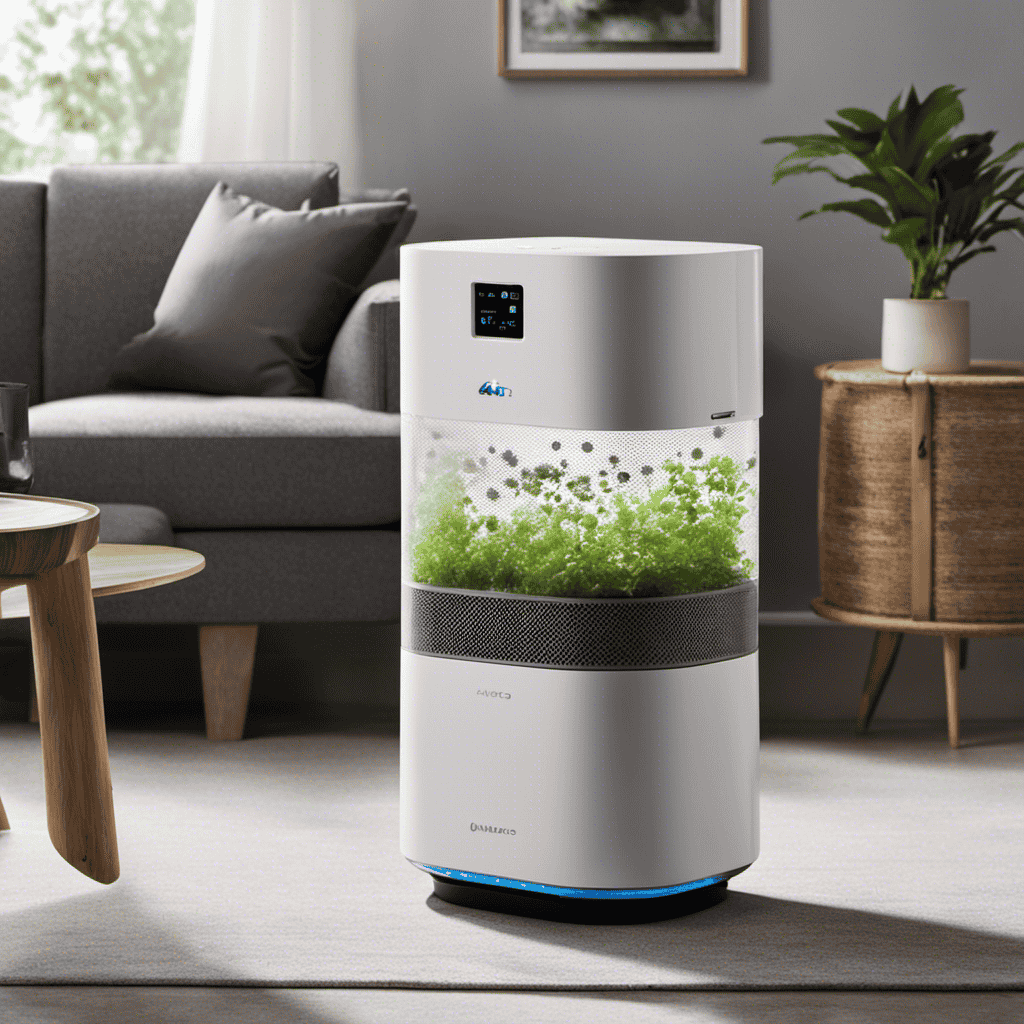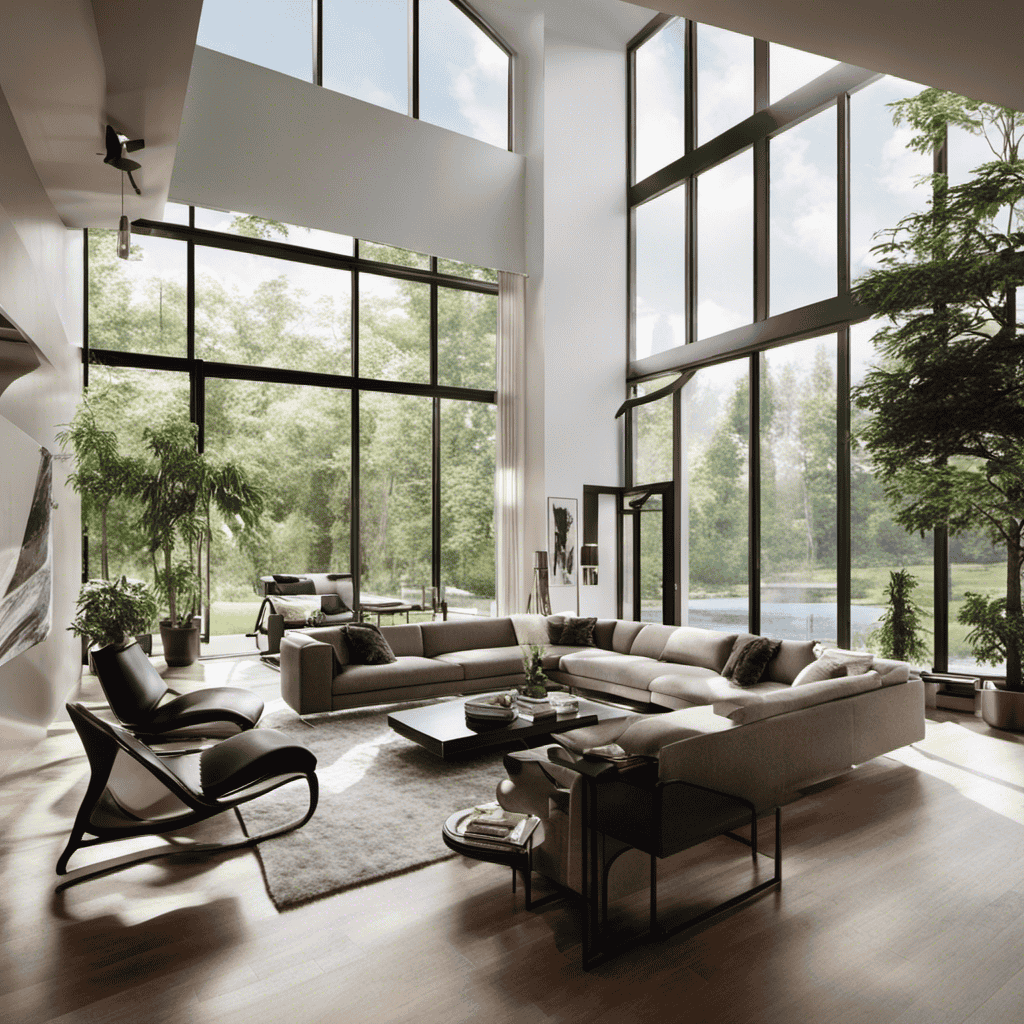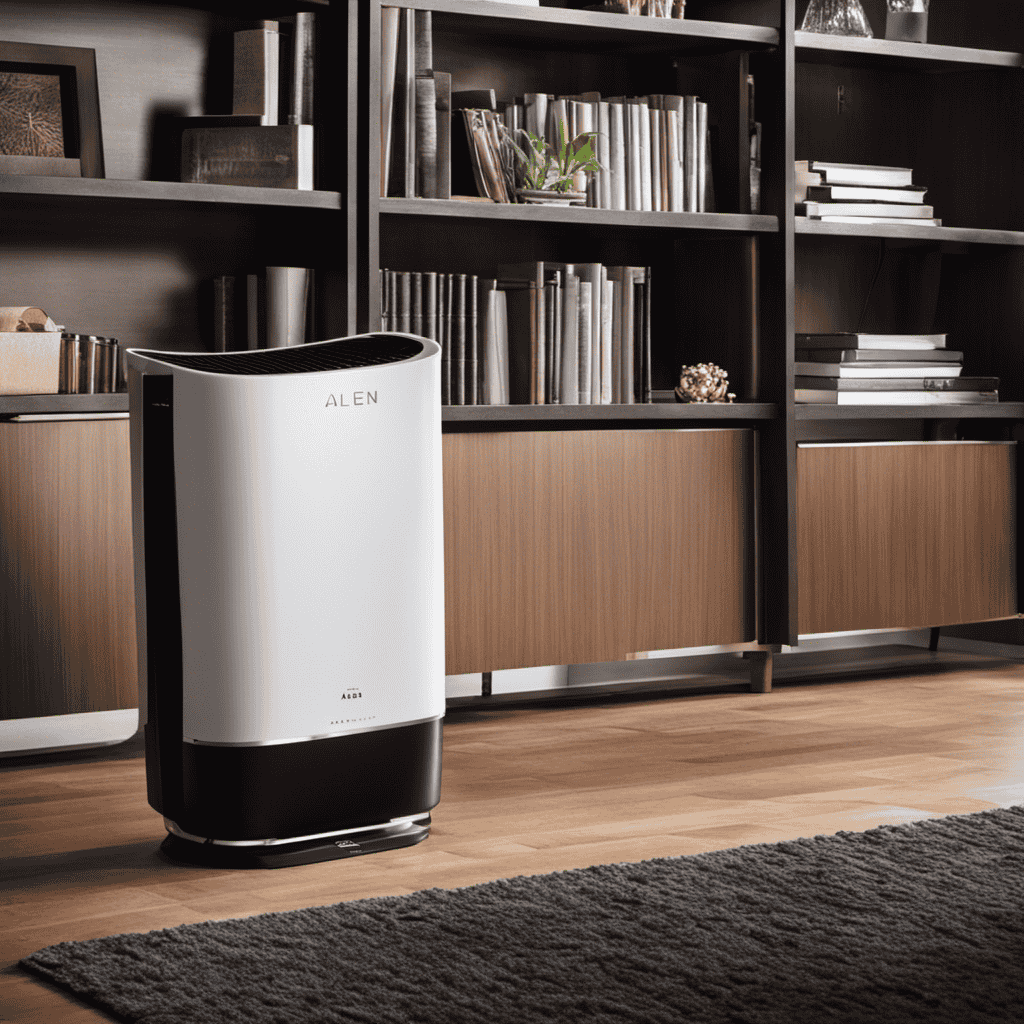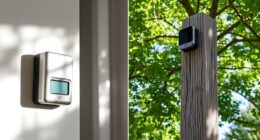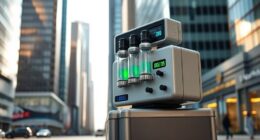I have exciting news to share with you – air purifiers are capable of eliminating even the smallest of particles! Indeed, these potent machines are engineered to combat the tiny particles that pose a threat to our indoor air quality.
But just how small are we talking? In this article, we’ll delve into the world of air purifier filtration and explore the smallest particle that these machines can effectively capture.
Get ready to discover the science behind clean air and find the perfect purifier for your needs.
Key Takeaways
- Air purifiers use filtration methods like HEPA filters and activated carbon filters to filter out harmful contaminants such as dust, pollen, and pet dander.
- HEPA filters can capture particles as small as 0.3 microns, including fine particulate matter (PM2.5) which can cause respiratory issues.
- Filtering small particles, especially PM2.5 particles, is essential for improving indoor air quality as they can penetrate deep into the lungs and bloodstream.
- Different air purifiers have different capabilities in filtering ultrafine particles, with HEPA filters having an efficiency of 99.97% in capturing particles as small as 0.3 microns.
Understanding Air Purifier Filtration
The air purifier filters out the smallest particles, ensuring that the air we breathe is free from harmful contaminants. Airborne contaminants, such as dust, pollen, and pet dander, can have a significant impact on our health and well-being.
Air quality standards set by organizations like the Environmental Protection Agency (EPA) aim to regulate the levels of these contaminants in indoor spaces. Air purifiers play a crucial role in achieving these standards by effectively removing particles as small as 0.3 microns in size.
Through a combination of filtration methods like HEPA filters and activated carbon filters, air purifiers trap and eliminate these tiny particles, improving the overall air quality.
Understanding the relationship between particle size and air purification is essential in selecting the right air purifier for your needs.
Particle Size and Air Purification
Particle size affects how well an air purifier can clean the air. The effectiveness of an air purifier in removing airborne contaminants depends on its ability to capture particles of various sizes. Here are some key points to consider:
-
Particle Size Range: Air purifiers are designed to filter particles within specific size ranges, typically ranging from 0.3 to 10 micrometers.
-
Fine Particulate Matter: Air pollution often contains fine particulate matter (PM2.5), which is less than 2.5 micrometers in diameter. These particles can penetrate deep into the lungs and cause respiratory issues.
-
HEPA Filters: High-Efficiency Particulate Air (HEPA) filters are commonly used in air purifiers to effectively capture particles as small as 0.3 micrometers, including PM2.5.
-
Additional Filtration Technologies: Some air purifiers incorporate additional filtration technologies like activated carbon filters and electrostatic precipitators to target specific pollutants.
Understanding the particle size range and the filtration capabilities of an air purifier is crucial in selecting the right device to effectively tackle airborne contaminants and improve indoor air quality.
Importance of Filtering Small Particles
Filtering small particles is essential for improving indoor air quality and reducing the risk of respiratory issues. Clean air is vital for maintaining good health, as air pollution can have severe health risks. Tiny particles, known as PM2.5, are the most concerning pollutants due to their ability to penetrate deep into the lungs and bloodstream. These particles can originate from various sources, such as vehicle emissions, industrial processes, and even cooking. To effectively remove these harmful particles from the air, air purifiers play a crucial role. They utilize specialized filters, such as HEPA filters, which have a high efficiency in capturing particles as small as 0.3 microns. By trapping these small particles, air purifiers can significantly reduce the presence of harmful pollutants in indoor spaces, ensuring cleaner and healthier air for everyone.
| Particle Size | Potential Sources |
|---|---|
| PM2.5 | Vehicle emissions, industrial processes, cooking |
| PM10 | Dust, pollen, mold spores, larger particles |
| PM0.1 | Ultrafine particles, combustion byproducts, viruses |
HEPA Filters and Micron Sizes
To effectively improve your indoor air quality, you should consider utilizing HEPA filters. These filters are highly efficient at capturing particles as small as 0.3 microns, making them one of the most effective methods for removing airborne pollutants.
Here are some key points to consider about HEPA filters and their effectiveness:
- HEPA filters can capture particles as small as 0.3 microns, including common allergens such as pollen, dust mites, and pet dander.
- The HEPA standard is based on the ability of the filter to remove at least 99.97% of particles of 0.3 microns in size.
- HEPA filters are designed with a densely packed fiber structure that creates a barrier for even the smallest particles.
- HEPA filters are used in various applications, including air purifiers, vacuum cleaners, and HVAC systems, making them versatile and widely available.
Capturing Ultrafine Particles With Air Purifiers
When it comes to capturing ultrafine particles with air purifiers, understanding the particle size limitations is crucial. Different air purifiers have different capabilities in terms of the smallest particle size they can effectively filter.
It is important to compare the filtering efficiency of various air purifiers to ensure that they can effectively capture the ultrafine particles that may be present in the air.
Particle Size Limitations
The smallest particle size an air purifier can filter depends on its technology. Different air purifier technologies have different capabilities when it comes to particle size distribution. Here are some key points to consider:
-
High-Efficiency Particulate Air (HEPA) filters: These filters are capable of capturing particles as small as 0.3 microns with an efficiency of 99.97%.
-
Activated carbon filters: While primarily designed to remove odors and chemicals, activated carbon filters can also capture larger particles in the range of 0.3 to 50 microns.
-
Electrostatic precipitators: These devices use an electrical charge to capture particles, including those as small as 0.01 microns.
-
Ultraviolet germicidal irradiation (UVGI): UVGI technology targets microorganisms like bacteria and viruses, but it has limited effectiveness against larger particles.
It’s important to choose an air purifier that suits your specific needs and addresses the particle size distribution you are concerned about.
Filtering Efficiency Comparison
In the previous section, we discussed the limitations of an air purifier in filtering particles based on their size. Now, let’s delve into the filtering efficiency comparison of different air purifiers, specifically those that use HEPA filter technology.
HEPA (High Efficiency Particulate Air) filters are commonly used in air purifiers due to their high efficiency in capturing small particles. These filters consist of a dense mat of fibers that can trap particles as small as 0.3 microns with an efficiency of 99.97%. To better understand the filtering capabilities of HEPA filters, let’s compare their efficiency with other types of filters commonly used in air purifiers:
| Filter Type | Particle Size Efficiency |
|---|---|
| HEPA Filter | 99.97% at 0.3 microns |
| Electrostatic Filter | Varies |
| Activated Carbon Filter | Varies |
As we can see from the table, HEPA filters offer the highest efficiency in capturing small particles compared to electrostatic and activated carbon filters. This makes HEPA filter technology the preferred choice for effectively removing various pollutants from the air.
Transitioning into the next section, understanding the filtering efficiency of air purifiers is crucial in determining the health benefits they provide.
Health Benefits Explained
HEPA filters, with their high efficiency in capturing small particles, provide significant health benefits. These filters are designed to remove airborne contaminants, improving the quality of the air we breathe. Here are some key health benefits of using HEPA filters for air purification:
-
Reduces allergens: HEPA filters can capture common allergens such as pollen, pet dander, and dust mites. This is especially beneficial for individuals with allergies or asthma.
-
Removes harmful particles: HEPA filters can effectively remove fine particles like smoke, bacteria, and viruses, helping to reduce the risk of respiratory infections.
-
Improves indoor air quality: By trapping pollutants, HEPA filters can help maintain a cleaner and healthier indoor environment.
-
Enhances sleep quality: Cleaner air can lead to better sleep, as it reduces the likelihood of breathing in irritants that can disrupt sleep patterns.
Investing in a HEPA filter for air purification can greatly improve your health and overall well-being.
The Role of Activated Carbon in Purifying Air
Activated carbon plays a crucial role in purifying air due to its unique properties. It effectively removes harmful pollutants by adsorbing them onto its surface, trapping them and preventing them from circulating in the air.
This process enhances indoor air quality, making it safer and healthier for occupants.
Carbon’s Air Purifying Properties
Did you know that carbon is effective at purifying the air? Carbon filtration is a widely used technology in air purifiers, and for good reason. Here are some key points to consider:
- Carbon has a porous structure that allows it to trap and absorb various pollutants and odors from the air.
- It is highly effective at removing volatile organic compounds (VOCs), such as formaldehyde and benzene, which can be harmful to our health.
- Carbon also helps to eliminate unpleasant smells, such as smoke, pet odors, and cooking fumes, making the air cleaner and fresher.
- This filtration method is commonly used in combination with other technologies, such as HEPA filters, to provide a comprehensive solution for indoor air purification.
Overall, carbon’s air purifying properties make it an essential component in modern air purifier technology, ensuring cleaner and healthier air for all.
Removing Harmful Pollutants
Carbon filtration is highly effective at trapping and absorbing harmful pollutants, ensuring cleaner and healthier air. With the advancements in air purifier technology, removing harmful gases from indoor spaces has become easier than ever before.
Carbon filters work by utilizing activated carbon, which has a large surface area and a high affinity for adsorption. This means that as air passes through the filter, the harmful gases are attracted to and trapped by the carbon, preventing them from re-entering the air. The porous structure of activated carbon allows for effective trapping of a wide range of pollutants, including volatile organic compounds (VOCs), odors, and chemicals.
These advancements in air purifier technology have greatly improved the quality of air indoors, providing a safer and healthier environment for individuals.
Transitioning into the next section, enhancing indoor air quality requires a comprehensive approach that goes beyond just removing pollutants.
Enhancing Indoor Air Quality
Improving indoor air quality involves implementing various strategies. These strategies include maintaining proper ventilation and using natural cleaning products. They are essential for enhancing ventilation and reducing allergens in the air.
Here are some effective methods to achieve better indoor air quality:
- Regularly clean and replace HVAC filters to trap dust and allergens.
- Keep windows open whenever possible to allow fresh air circulation.
- Use air purifiers with HEPA filters to capture small particles and allergens.
- Keep indoor humidity levels between 30% and 50% to prevent mold growth.
Implementing these strategies will help create a healthier indoor environment by reducing the presence of airborne pollutants and allergens.
Now, let’s explore the next section on evaluating air purifier effectiveness for small particles.
Evaluating Air Purifier Effectiveness for Small Particles
When evaluating air purifier effectiveness for small particles, it’s important to consider the size of the smallest particle that the purifier can filter. Different air purifier technologies have varying capabilities when it comes to capturing and removing small particles from the air. To compare the performance of air purifiers, it is helpful to examine the minimum particle size that each technology can effectively filter.
Below is a table that compares three commonly used air purifier technologies and their particle filtration capabilities:
| Technology | Minimum Particle Size Filtered |
|---|---|
| HEPA | 0.3 microns |
| Activated Carbon | 0.01 microns |
| Electrostatic Precipitator | 0.01 microns |
As shown in the table, HEPA filters can effectively capture particles as small as 0.3 microns, while activated carbon and electrostatic precipitators can filter particles as small as 0.01 microns. This information can help consumers make informed decisions when selecting an air purifier that best suits their needs.
Tips for Choosing an Air Purifier for Small Particle Filtration
To effectively select an air purifier for filtering small particles, it’s crucial to consider the technology used and its filtration capabilities. Here are some tips for choosing the right air purifier:
- Look for High-Efficiency Particulate Air (HEPA) filters, which can capture particles as small as 0.3 microns.
- Consider the Clean Air Delivery Rate (CADR), which measures the purifier’s ability to remove pollutants from the air.
- Avoid ozone-generating purifiers, as they can be harmful to your health.
- Don’t fall for the misconception that a larger purifier is always better; the size should be appropriate for the room you plan to use it in.
Once you have selected an air purifier, it’s important to maintain it properly. Regularly clean or replace the filters, as dirty filters can reduce the purifier’s efficiency. Additionally, be aware of common misconceptions about air purifiers, such as their ability to eliminate all indoor pollutants. While air purifiers can significantly improve indoor air quality, they may not eliminate all contaminants.
Frequently Asked Questions
Can Air Purifiers Remove Odors From the Air?
Yes, air purifiers can effectively remove odors from the air. Different types of air purifiers, such as activated carbon filters, are designed to trap and eliminate odorous particles, providing fresher and cleaner air.
How Often Do Air Purifier Filters Need to Be Replaced?
Air purifier maintenance is crucial to ensure clean air. Signs of a dirty air filter include reduced airflow and a buildup of dust. Regularly replacing air purifier filters is recommended for optimal performance.
Can Air Purifiers Effectively Remove Allergens Like Pollen and Pet Dander?
Yes, air purifiers can effectively remove allergens like pollen and pet dander. They are designed to filter out particles as small as 0.3 microns, improving indoor air quality. However, they may not effectively remove viruses and bacteria.
Are There Any Health Risks Associated With Using Air Purifiers?
Using air purifiers for extended periods may lead to dryness, irritation, and discomfort in the throat and eyes. Regular air purifier maintenance, such as cleaning and filter replacement, can help minimize potential side effects.
Can Air Purifiers Help With Respiratory Conditions Such as Asthma or Copd?
Air purifiers can help with respiratory conditions like asthma and COPD. They filter out allergens and pollutants from the air, improving indoor air quality. However, the smallest particle they can filter depends on the specific purifier.
Conclusion
In conclusion, the journey of understanding air purifier filtration has been enlightening.
Like a wise old oak tree, the air purifier stands tall, filtering out the smallest particles with its powerful HEPA filters and activated carbon.
Just as the oak tree provides shelter and protection, the air purifier shields us from the invisible threats that lurk in our air.
So, my friends, when choosing an air purifier, remember to look for one that can withstand the storm of small particles, for it is in those tiny particles that the true power of purification lies.
